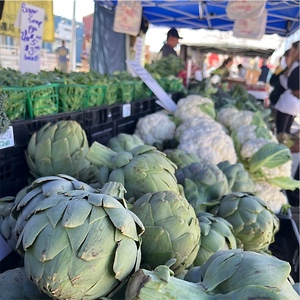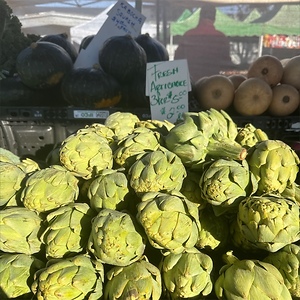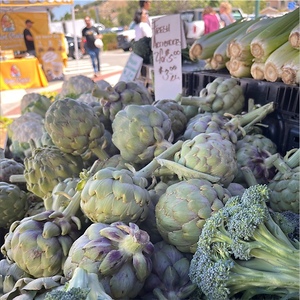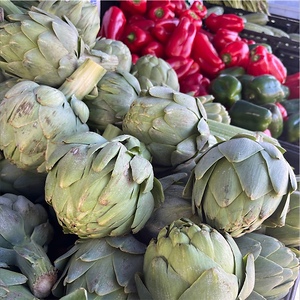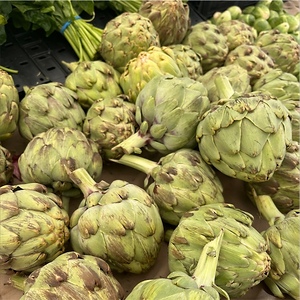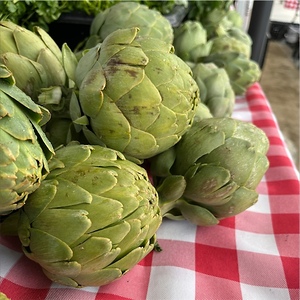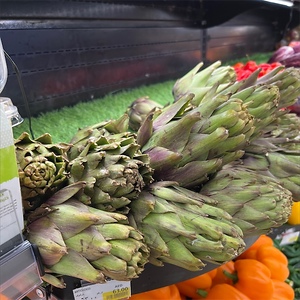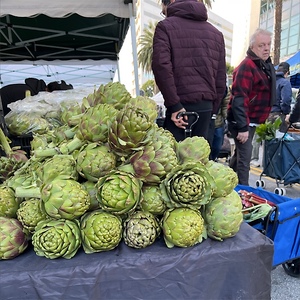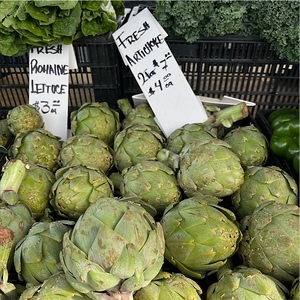


Artichokes With Thorns
Estimated Inventory, 24 ct : 1.75
This item was last sold on : 04/17/25
Description/Taste
Thorny artichokes widely vary in size and shape, depending on the variety, and generally exhibit a conical to rounded appearance. The unopened flower buds are compact, comprised of tight layers of triangular, slightly pointed green to purple bracts, sometimes referred to as leaves. At the top of the pointed bracts, a tiny thorn arises from the center, sometimes hooked, needle-like, and very sharp. Each Thorny artichoke variety will have a different type of thorn depending on pedigree and cultivation. The thick bracts are fleshy and somewhat curved, and as each layer is peeled away, the color of the bracts transforms from green to pale yellow or purple. The bracts grow smaller and smaller towards the interior, revealing a central, fleshy heart surrounded by immature florets known as the choke. Thorny artichokes should feel heavy for their size, an indication of a large edible core, and when the buds are gently squeezed, they should emit a sound referred to as a squeak. When cooked, the lower, fleshy base of the bracts and the heart are the only portions consumed. These bracts and heart develop a soft and tender consistency and have a green, nutty, and slightly tangy vegetal flavor.
Seasons/Availability
Thorny artichokes are available year-round, with a peak season in the spring.
Current Facts
Thorny artichokes, botanically classified as Cynara scolymus, is a general descriptor used for several artichoke varieties that display tiny thorns on their leaf tips. These varieties belong to the Asteraceae family and are immature flower heads of herbaceous perennials. The unopened flower buds grow on a large plant of thick stalks and leaves that reach anywhere from 1 to 5 meters in height. Experts believe there are over 140 varieties of artichokes worldwide, with approximately 40 varieties grown commercially. Artichokes are further categorized into thornless and thorned cultivars and are distinguished by their leaf coloring, generally purple or green. Thorny artichoke varieties include but are not limited to Imperial Star, Desert Globe, Emerald, Big Heart, and Green Globe, with Green Globe being one of the most commercially produced types. There are also more boutique thorny cultivars grown and sold throughout Italy, including Sardinian artichokes, which were given a protected designation of origin or PDO. In modern-day markets, thorny and thornless artichokes are typically interchanged in recipes calling for artichokes. According to some artichoke growers, Thorny artichokes have been observed to contain a slightly more robust flavoring than thornless cultivars, but this has yet to be proven.
Nutritional Value
Thorny artichokes are a source of potassium to balance fluid levels within the body, calcium to build strong bones and teeth, and folate to promote the production of healthy red blood cells. The artichokes also provide moderate amounts of vitamin K to assist in faster wound healing, magnesium to control healthy nerve functioning, vitamin C to strengthen the immune system, and other nutrients, including manganese, phosphorus, vitamin A, and iron.
Applications
Thorny artichokes are a versatile ingredient used in any recipe calling for artichokes. Care should be taken when handling the raw artichokes, as the thorns can be very sharp on the end of each leaf, depending on the variety. These thorns can be cut off the top of the leaf with scissors, or they may soften slightly when cooked. It is important to note that the thorns are never consumed and should always be discarded. When preparing Thorny artichokes, the buds should be immersed in a mixture of water and lemon juice or sparkling mineral water to prevent the leaves from oxidizing and turning brown. Thorny artichokes have a nutty, tangy, and grassy flavor and are traditionally boiled or steamed to create a soft and tender consistency. Once cooked, each bract can be removed individually by hand, and the fleshy bottom can be dipped in sauces such as mayonnaise, balsamic vinegar, hollandaise, butter, olive oil, aioli, or fresh lemon juice and consumed in one bite. Halved artichokes can also be stuffed with herbs, cheese, meats, and breadcrumbs and baked as a savory dish. In addition to consuming the bracts, Thorny artichoke varieties can be cooked and consumed solely for their central heart. The hearts can be cooked and topped with cheese as an appetizer, mixed into pasta and risotto, tossed into grain bowls, stuffed into empanadas, stirred into salads, or sprinkled on pizza. They can also be cooked into paella, mixed into stews, or sautéed into egg-based dishes. Beyond culinary preparations, the leaves and flowers can be dried and steeped in hot water to make a woody, slightly bitter herbal tea. Thorny artichokes pair well with spices such as allspice, black pepper, and garlic, meats including lamb, poultry, beef, and turkey, herbs such as parsley, dill, and mint, white wine, mushrooms, carrots, celery, and potatoes. Whole, unwashed Thorny artichokes will keep 1 to 2 weeks when stored in a plastic bag in the refrigerator.
Ethnic/Cultural Info
In Greek mythology, Thorny artichokes were created from a love affair between Zeus and a woman named Cynara. Legend has it that Zeus was visiting his brother Poseidon on a small Aegean Island when he noticed a beautiful woman. Zeus was overtaken by Cynara’s beauty and convinced her to live on Mount Olympus as a goddess to meet him in secret when his wife Hera was out. Cynara agreed and went with Zeus, but over time, she began to grow tired of Mount Olympus and snuck out to visit her mother. Zeus discovered Cynara’s secret rendezvous and was infuriated that she would act like a human more than a goddess. In his anger, her flung her from Mount Olympus, transforming her into an artichoke as she landed back on Earth. Artichokes bloom large, vibrant, and beautiful purple flowers if the buds are left on the plant, symbolizing Cynara’s beauty. This myth has led many Greeks to refer to the thistle-like plants simply as Cynara, and it is also rumored the artichokes scientific name, Cynara scolymus, was inspired by the Grecian beauty’s name.
Geography/History
Thorny artichokes are descendants of ancient varieties native to the regions surrounding the Mediterranean Sea, believed by experts to be related to the wild cardoon, a thistle-like plant initially found in Northwest Africa. It is unknown when Thorny artichokes were selected and developed through natural cultivation techniques, but artichokes were mentioned in several Greek and Roman writings in the late BCE eras and the 1st century CE. Thorny artichokes were eventually produced for commercial markets in Europe, and the plants were spread across Southern Europe into France, eventually making their way into England. Thorny artichokes were carried to the United States through French and Spanish immigrants in the 19th century and were planted throughout Louisiana and coastal California. The sharp spined varieties also increased in popularity during the 20th century as production of the buds expanded across international markets. Today Thorny artichokes are grown in the Mediterranean basin, with concentrated commercial production in Italy. Some Thorny artichoke varieties are also cultivated in California in the United States, Peru, Argentina, Australia, and Africa.
Featured Restaurants
Restaurants currently purchasing this product as an ingredient for their menu.
| Pitchers | San Diego CA | 858-472-1251 |
| Crust Pizzeria Solana Beach | Solana Beach CA | 858-212-8751 |
| Olive Tree Marketplace | San Diego CA | 619-224-0443 |
| Adobo House | San Diego CA | 619-990-8340 |
| The Remy (bar) | San Diego CA | 619-886-1358 |
Recipe Ideas
Recipes that include Artichokes With Thorns. One



